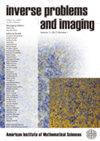由粗糙界面分离的两层介质中逆源问题的稳定性
IF 1.5
4区 数学
Q2 MATHEMATICS, APPLIED
引用次数: 0
摘要
本文研究了两层介质中二维亥姆霍兹方程的逆源问题。假设两种介质之间的界面是非局部粗糙的,而紧支撑的未知源则埋在下半部介质中。对于正演问题,我们基于角谱表示和Hankel函数的渐近性证明了波场的辐射行为。对于反问题,利用有限孔径的多频界面测量,我们给出了一个递增的稳定性估计,它由两部分组成:一部分是Hölder稳定性估计,另一部分是对数稳定性估计。后者随着频率上界的增大而减小。在稳定性的推导中,我们要求源函数具有H^3的正则性以控制其傅里叶变换的高频尾部。为了在数值上恢复源,我们提出了一种不完全数据下的递归Kaczmarz-Landweber迭代方案。数值算例验证了该方法的理论稳定性估计和有效性。本文章由计算机程序翻译,如有差异,请以英文原文为准。
Stability for the inverse source problem in a two-layered medium separated by rough interface
In this paper, we investigate an inverse source problem for the two-dimensional Helmholtz equation in a two-layered medium. The interface between two media is assumed to be nonlocal and rough, while the compactly supported unknown source is buried in the lower-half medium. For the forward problem, we prove the radiating behaviour of the wave field based on the Angular Spectrum Representation and the asymptotics of Hankel functions. For the inverse problem, using multi-frequency interface measurements, which are limited-aperture, we show an increasing stability estimate which consists of two parts: one part is a Hölder stability estimate, the other part is a logarithmic stability estimate. The latter decreases as the upper bound of the frequency increases. In the derivation of the stability, we require the source function to have an $ H^3 $ regularity to control the high frequency tail of its Fourier transform. To recover the source numerically, we propose a recursive Kaczmarz-Landweber iteration scheme with incomplete data. Numerical examples are presented to justify the theoretical stability estimate and validity of the scheme.
求助全文
通过发布文献求助,成功后即可免费获取论文全文。
去求助
来源期刊

Inverse Problems and Imaging
数学-物理:数学物理
CiteScore
2.50
自引率
0.00%
发文量
55
审稿时长
>12 weeks
期刊介绍:
Inverse Problems and Imaging publishes research articles of the highest quality that employ innovative mathematical and modeling techniques to study inverse and imaging problems arising in engineering and other sciences. Every published paper has a strong mathematical orientation employing methods from such areas as control theory, discrete mathematics, differential geometry, harmonic analysis, functional analysis, integral geometry, mathematical physics, numerical analysis, optimization, partial differential equations, and stochastic and statistical methods. The field of applications includes medical and other imaging, nondestructive testing, geophysical prospection and remote sensing as well as image analysis and image processing.
This journal is committed to recording important new results in its field and will maintain the highest standards of innovation and quality. To be published in this journal, a paper must be correct, novel, nontrivial and of interest to a substantial number of researchers and readers.
 求助内容:
求助内容: 应助结果提醒方式:
应助结果提醒方式:


